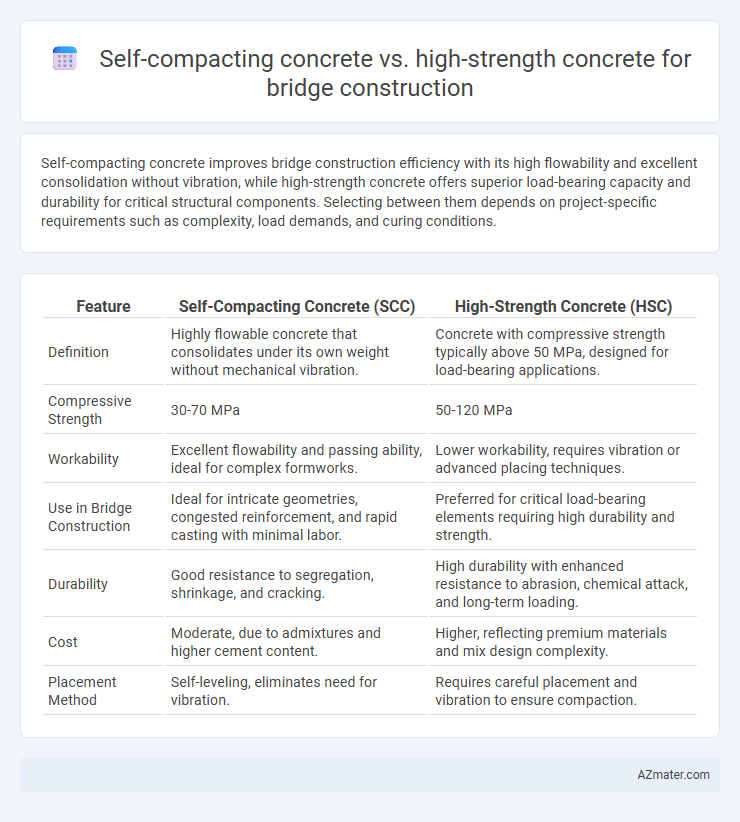Self-compacting concrete improves bridge construction efficiency with its high flowability and excellent consolidation without vibration, while high-strength concrete offers superior load-bearing capacity and durability for critical structural components. Selecting between them depends on project-specific requirements such as complexity, load demands, and curing conditions.
Table of Comparison
| Feature | Self-Compacting Concrete (SCC) | High-Strength Concrete (HSC) |
|---|---|---|
| Definition | Highly flowable concrete that consolidates under its own weight without mechanical vibration. | Concrete with compressive strength typically above 50 MPa, designed for load-bearing applications. |
| Compressive Strength | 30-70 MPa | 50-120 MPa |
| Workability | Excellent flowability and passing ability, ideal for complex formworks. | Lower workability, requires vibration or advanced placing techniques. |
| Use in Bridge Construction | Ideal for intricate geometries, congested reinforcement, and rapid casting with minimal labor. | Preferred for critical load-bearing elements requiring high durability and strength. |
| Durability | Good resistance to segregation, shrinkage, and cracking. | High durability with enhanced resistance to abrasion, chemical attack, and long-term loading. |
| Cost | Moderate, due to admixtures and higher cement content. | Higher, reflecting premium materials and mix design complexity. |
| Placement Method | Self-leveling, eliminates need for vibration. | Requires careful placement and vibration to ensure compaction. |
Introduction to Modern Concrete Types in Bridge Construction
Self-compacting concrete (SCC) offers superior flowability and consolidation without mechanical vibration, making it ideal for complex bridge formworks and reducing labor costs. High-strength concrete (HSC) provides exceptional compressive strength, enhancing the load-bearing capacity and durability of bridge components under heavy traffic and harsh environmental conditions. Both modern concrete types contribute to prolonging the lifespan and performance of bridges by addressing specific structural and construction challenges.
Defining Self-Compacting Concrete (SCC)
Self-compacting concrete (SCC) is a highly flowable, non-segregating material that can spread into place, fill formwork, and encapsulate reinforcement without mechanical vibration. Its unique rheological properties improve workability, reduce construction time, and enhance structural durability, making it advantageous for complex bridge geometries. Compared to high-strength concrete, SCC emphasizes ease of placement and uniformity, essential for minimizing voids and ensuring quality in bridge construction.
Understanding High-Strength Concrete (HSC)
High-strength concrete (HSC) for bridge construction typically features compressive strengths exceeding 6,000 psi (41 MPa), enabling it to support heavier loads and reduce structural member sizes. Its dense microstructure enhances durability and resistance to environmental factors like chloride penetration and freeze-thaw cycles, crucial for bridge longevity. HSC's performance is optimized through precise mix designs incorporating supplementary cementitious materials and chemical admixtures to achieve improved workability and strength without compromising quality.
Key Material Properties: SCC vs HSC
Self-compacting concrete (SCC) exhibits superior flowability and filling ability without segregation, ensuring excellent workability in complex bridge geometries. High-strength concrete (HSC) offers higher compressive strength, typically exceeding 60 MPa, making it ideal for load-bearing bridge components. SCC's reduced water-cement ratio and enhanced viscosity modifiers provide improved durability and reduced permeability compared to traditional mixtures, while HSC's densified microstructure enhances mechanical performance but may require stringent curing conditions.
Workability and Placement: SCC Advantages
Self-compacting concrete (SCC) offers superior workability and ease of placement compared to high-strength concrete (HSC), eliminating the need for mechanical vibration and reducing labor costs on bridge construction sites. SCC's high flowability allows it to fill complex formworks and densely reinforced sections uniformly, minimizing voids and ensuring consistent quality. This enhanced placement efficiency and surface finish make SCC particularly advantageous for intricate bridge components, improving overall structural integrity and project timelines.
Structural Performance: HSC Benefits
High-strength concrete (HSC) offers superior compressive strength typically above 50 MPa, providing enhanced load-bearing capacity and durability for bridge structures. Its reduced permeability increases resistance to environmental aggressors like chlorides and freeze-thaw cycles, significantly extending the bridge's service life. HSC also enables slender, more efficient structural elements, optimizing material use and reducing overall bridge weight without compromising safety.
Durability and Long-Term Maintenance
Self-compacting concrete (SCC) enhances durability in bridge construction through superior flowability, reducing voids and ensuring better compaction, which minimizes permeability and susceptibility to corrosion. High-strength concrete (HSC) offers enhanced compressive strength, contributing to load-bearing capacity but may require additional measures to mitigate microcracking that can affect long-term durability. Maintenance needs for SCC are generally lower due to its homogeneous structure and reduced segregation, whereas HSC may necessitate more frequent inspections and repairs to address potential cracking and durability concerns under sustained loads and environmental exposure.
Cost Implications in Bridge Projects
Self-compacting concrete (SCC) reduces labor costs and accelerates construction schedules in bridge projects due to its superior flowability and ease of placement, minimizing the need for vibration and formwork adjustments. High-strength concrete (HSC) increases material costs given its higher cement content and specialized admixtures but enables slimmer structural elements, potentially reducing overall material volume and foundation expenses. Balancing SCC's reduced construction time against HSC's material efficiency is critical for cost-optimized bridge design and execution.
Case Studies: Successful Bridge Applications
Self-compacting concrete (SCC) enhances bridge construction by improving workability and reducing labor costs, demonstrated in the Ryerson Bridge, where its fluidity enabled complex formworks and faster casting. High-strength concrete (HSC) offers superior load-bearing capacity and durability, exemplified by the Millau Viaduct, which benefits from HSC's ability to support long spans and heavy traffic. Case studies reveal that SCC is preferred for intricate designs requiring rapid placement, while HSC is optimal for structures demanding exceptional strength and longevity.
Selecting the Right Concrete for Your Bridge Project
Self-compacting concrete (SCC) offers superior flowability and reduced labor costs, making it ideal for complex bridge geometries and congested reinforcement areas, while high-strength concrete (HSC) provides enhanced compressive strength for load-bearing components and longer spans. Selecting the right concrete involves evaluating project-specific factors such as structural demands, environmental exposure, and construction speed. Optimal bridge performance is achieved by balancing SCC's workability benefits with HSC's durability and strength characteristics to meet both design and longevity requirements.

Infographic: Self-compacting concrete vs High-strength concrete for Bridge construction
 azmater.com
azmater.com